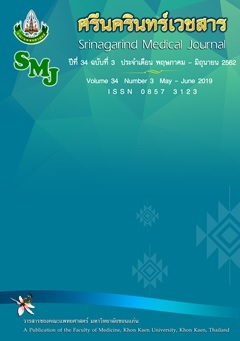Predictive Equation of Knee Extensor Muscle Strength in Elderly Adults Determined by 5 Time Sit-to-Stand Performance
Keywords:
Sit-to-Stand Test, Knee Extensor Muscle Strength, Elderly, Prediction, การทดสอบลุกขึ้นยืนจากนั่ง, ความแข็งแรงของกล้ามเนื้อเหยียดเข่า, ผู้สูงอายุ, การทำนายAbstract
สมการทำนายความแข็งแรงของกล้ามเนื้อเหยียดเข่าในผู้สูงอายุโดยใช้ความสามารถในการลุกขึ้นยืนจากนั่ง 5 ครั้ง
วีระศักดิ์ ต๊ะปัญญา*, นพรัตน์ สังฆฤทธิ์, สายสุนีย์ คนสนิท
สาขาวิชากายภาพบำบัด คณะสหเวชศาสตร์ มหาวิทยาลัยพะเยา
หลักการและวัตถุประสงค์: ผู้สูงอายุเป็นวัยที่มีความเสี่ยงต่อการหกล้มเพิ่มขึ้น เนื่องมาจากการลดลงของความแข็งแรงของกล้ามเนื้อเหยียดเข่า ซึ่งเป็นปัจจัยเสี่ยงหนึ่งของการหกล้มในผู้สูงอายุ ดังนั้นการประเมินความแข็งแรงของกล้ามเนื้อเหยียดเข่าจึงมีความสำคัญเป็นอย่างมาก วัตถุประสงค์ของการศึกษานี้คือ ศึกษาหาสมการในการทำนายความแข็งแรงของกล้ามเนื้อเหยียดขาจากตัวแปรจากการทดสอบความสามารถในการลุกขึ้นยืนจากนั่ง และตัวแปรข้อมูลพื้นฐานทางกายภาพของผู้ถูกทดสอบ
วิธีการศึกษา: ทำการศึกษาในผู้สูงอายุสุขภาพดี อายุ 60 ปีขึ้นไป จำนวน 56 ราย (อายุเฉลี่ย 67.59 ± 7.35 ปี) อาสาสมัครทั้งหมดได้รับการบันทึกค่าตัวแปรพื้นฐานทางกายภาพ ทดสอบลุกขึ้นยืนจากนั่ง 5 ครั้ง และทำการทดสอบความแข็งแรงของกล้ามเนื้อเหยียดเข่าด้วย Push-pull Dynamometer ใช้สถิติ Multiple regression analysis เพื่อหาสมการทำนายค่าความแข็งแรงของกล้ามเนื้อเหยียดเข่าโดยกำหนดระดับนัยสำคัญทางสถิติที่ p < 0.05
ผลการศึกษา: ได้สมการที่เหมาะสมและสามารถทำนายความแข็งแรงของกล้ามเนื้อเหยียดเข่าจากตัวแปรเพศ น้ำหนัก และเวลาที่ทำการลุกขึ้นยืนจากนั่ง 5 ครั้ง คือ ความแข็งแรงของกล้ามเนื้อเหยียดเข่า = 39.055 + 5.349 (เพศ) + 0.150 (น้ำหนักตัว) – 2.981 (เวลาที่ทำการลุกขึ้นยืนจากนั่ง 5 ครั้ง) ± 4.37 กิโลกรัม ซึ่งมีความสัมพันธ์ในระดับสูง (r = 0.891) โดยมีอำนาจในการทำนายร้อยละ 78.2 และมีค่าความคาดเคลื่อนในการทำนายเท่ากับ 4.37 กิโลกรัม
สรุป: ตัวแปรเพศ น้ำหนัก และระยะเวลาในการทดสอบลุกขึ้นยืนจากนั่ง เป็นตัวแปรที่มีผลต่อความแข็งแรงของกล้ามเนื้อเหยียดข้อเข่า และนำมาใช้สร้างสมการในการทำนายความแข็งแรงของกล้ามเนื้อเหยียดเข่าในผู้สูงอายุได้
Background and Objective: The older adults are aged at increased risk of falling due to decrease in the knee extensor muscle strength that is one of risk factor of falling in elderly. Thus, the assessment of the strength of the knee is very important. Therefore, the purpose of this study was to define the prediction equation of knee extensor muscle strength from the performance of 5 time sit to stand test (5-STS) and demographic data variable.
Method: Fifty-six healthy elders (mean age 67.59 ± 7.35 years) (28 males and 28 females) who aged more than 60 years were asked to provide the demographic data and performed 5-STS. All participants were evaluated knee extensor strength by Push-pull dynamometer. The multiple regression analysis was used to explore knee extensor strength prediction equation and significant levels were set at p < 0.05.
Results: The results showed that the knee extensor strength prediction equation were established by variables obtain from gender, weight and time to complete 5-STS, knee extensor strength = 39.055 + 5.349 (gender) + 0.150 (weight) – 2.981 (time to complete 5-STS) ± 4.37 kilograms, with high correlation (r = 0.891) and 78.2 percent of power of estimation. This equation had an error of estimation about 4.37 kilograms.
Conclusion: The gender, weight and time to 5-STS were the factors which influence knee extensor strength and could be used to predict knee extensor strength in elderly adults.
References
Ploutz-Snyder LL, Manini T, Ploutz-Snyder RJ, Wolf DA. Functionally relevant thresholds of quadriceps femoris strength. J Gerontol A Biol Sci Med Sci 2002; 57: B144-52.
Cheng YY, Wei SH, Chen PY, Tsai MW, Cheng IC, Liu DH, et al. Can sit-to-stand lower limb muscle power predict fall status? Gait Posture 2014; 40: 403-7.
Stevens JA, Corso PS, Finkelstein EA, Miller TR. The costs of fatal and non‐fatal falls among older adults. Inj Prev 2006; 12: 290-5.
Cho KH, Bok SK, Kim Y-J, Hwang SL. Effect of Lower Limb Strength on Falls and Balance of the Elderly. Ann Rehabil Med 2012; 36: 386-93.
Fleming BE, Wilson DR, Pendergast DR. A portable, easily performed muscle power test and its association with falls by elderly persoms. Arch Phys Med Rehabil 1991; 72: 886-9.
Miszko TA, Cress ME, Slade JM, Covey CJ, Agrawal SK, Doerr CE. Effect of strength and power training on physical function in community-dwelling older adults. J Gerontol A Biol Sci Med Sci 2003; 58: 171-5.
Portegijs E, Sipila S, Pajala S, Lamb SE, Alen M, Kaprio J, et al. Asymmetrical lower extremity power deficit as a risk factor for injurious falls in healthy older women. J Am Geriatr Soc 2006; 54: 551-3.
Bohannon RW. Alternatives for measuring knee extension strength of the elderly at home. Clin Rehabil 1998; 12: 434-40.
Csuka M, McCarty DJ. Simple method for measurement of lower extremity muscle strength. Am J Med 1985; 78 :77-81.
Hughes MA, Myers BS, Schenkman ML. The role of strength in rising from a chair in the functionally impaired elderly. J Biomech 1996; 29: 1509-13.
Jones CJ, Rikli RE, Beam WC. A 30-s chair-stand test as a measure of lower body strength in community-residing older adults. Res Q Exerc Sport 1999; 70: 113-9.
Corrigan D, Bohannon RW. Relationship between knee extension force and stand-up performance in community-dwelling elderly women. Arch Phys Med Rehabil 2001; 82: 1666-72.
Takai Y, Ohta M, Akagi R, Kanehisa H, Kawakami Y, Fukunaga T. Sit-to-stand test to evaluate knee extensor muscle size and strength in the elderly: a novel approach. J Physiol Anthropol 2009; 28: 123-8.
Chen BB, Shih TTF, Hsu CY, Yu CW, Wei SY, Chen CY, et al. Thigh muscle volume predicted by anthropometric measurements and correlated with physical function in the older adults. J Nutr Health Aging 2011; 15: 433-8.
Sleivert GG, Wenger HA. Reliability of measuring isometric and isokinetic peak torque, rate of torque development, integrated electromyography, and tibia1 nerve conduction velocity. Arch Phys Med Rehabil 1994; 75: 1315-321.
Yamada T, Demura S. Influence of the relative difference in chair seat height according to different lower thigh length on floor reaction force and lower-limb strength during sit-to-stand movement. J Physiol Anthropol Appl Human Sci 2004; 23: 197-203.
Bishop P, Cureton K, Collins M. Sex difference in muscular strength in equally-trained men and women. Ergonomics 1987; 30: 675-87.
Slemenda C, Heilman DK, Brandt KD, Katz BP, Mazzuca SA, Braunstein EM, et al. Reduced quadriceps strength relative to body weight: a risk factor for knee osteoarthritis in women? Arthritis Rheum 1998; 41: 1951-9.
Miyatake N, Miyachi M, Tabata I, Sakano N, Hirao T, Numata T. Relationship between muscle strength and anthropometric, body composition parameters in Japanese adolescents. Health (N Y) 2012; 4: 5.
Bazyler CD, Beckham GK, Sato K. The use of the isometric squat as a measure of strength and explosiveness. J Strength Cond Res 2015; 29: 1386-92.
McCarthy EK, Horvat MA, Holtsberg PA, Wisenbaker JM. Repeated chair stands as a measure of lower limb strength in sexagenarian women. J Gerontol A Biol Sci Med Sci 2004; 59: 1207-12.


